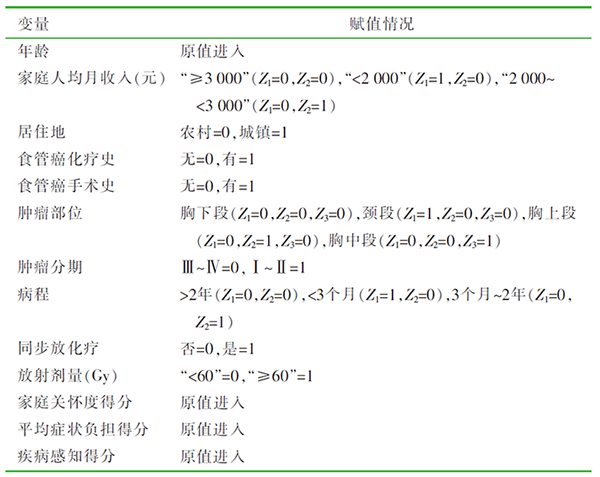| [1] |
Sung H, Ferlay J, Siegel RL, et al. Global cancer statistics 2020:GLOBOCAN estimates of incidence and mortality worldwide for 36 cancers in 185 countries[J]. CA Cancer J Clin, 2021, 71(3):209-249.
|
| [2] |
中国医师协会放射肿瘤治疗医师分会, 中华医学会放射肿瘤治疗学分会, 中国抗癌协会肿瘤放射治疗专业委员会. 中国食管癌放射治疗指南(2023年版)[J]. 国际肿瘤学杂志, 2024, 51(1):1-20.
|
| [3] |
苏晓雨, 王青青, 刘风侠. 食管癌放疗病人症状群的纵向研究[J]. 护理研究, 2023, 37(1):12-20.
|
| [4] |
Riba MB, Donovan KA, Andersen B, et al. Distress management,version 3. 2019,NCCN clinical practice guidelines in oncology[J]. J Natl Compr Canc Netw, 2019, 17(10):1229-1249.
|
| [5] |
中共中央, 国务院. 健康中国2030规划纲要[EB/OL].(2016-10-25). https://www.gov.cn/zhengce/2016-10/25/content_5124174.htm.
|
| [6] |
邱晶, 齐榕, 陈俊强. 食管癌放疗病人心理痛苦水平及影响因素的纵向研究[J]. 循证护理, 2024, 10(13):2383-2387.
|
| [7] |
王俊杰, 陈依娜, 陆梦依, 等. 三种轨迹分析方法的比较研究[J]. 中国卫生统计, 2024, 41(3):331-338.
|
| [8] |
张叶宁, 张海伟, 宋丽莉, 等. 心理痛苦温度计在中国癌症患者心理痛苦筛查中的应用[J]. 中国心理卫生杂志, 2010, 24(12):897-902.
|
|
Zhang YN, Zhang HW, Song LL, et al. Application of the NCCN Distress Thermometer in Chinese cancer patients[J]. Chin Ment Health J, 2010, 24(12):897-902.
|
| [9] |
Wang XS, Williams LA, Eng C, et al. Validation and applica-tion of a module of the M. D. Anderson Symptom Inventory for measuring multiple symptoms in patients with gastrointes-tinal cancer(the MDASI-GI)[J]. Cancer, 2010, 116(8):2053-2063.
|
|
陈仁旺. MDASI-GI中文版的信效度检验及临床应用研究[D]. 武汉: 华中科技大学,2019.
|
| [11] |
Broadbent E, Petrie KJ, Main J, et al. The brief illness percep-tion questionnaire[J]. J Psychosom Res, 2006,60(6):631-637.
|
| [12] |
梅雅琪, 李惠萍, 杨娅娟, 等. 中文版疾病感知问卷简化版在女性乳腺癌患者中的信效度检验[J]. 护理学报,2015, 22(24):11-14.
|
| [13] |
Smilkstein G. The family APGAR:a proposal for a family fun-ction test and its use by physicians[J]. J Fam Pract, 1978, 6(6):1231-1239.
|
| [14] |
吕繁, 顾湲. 家庭APGAR问卷及其临床应用[J]. 国外医学(医院管理分册), 1995, 12(2):56-59.
|
| [15] |
杨婷婷, 童叶青, 殷晓旭, 等. Morisky服药依从性量表、家庭APGAR问卷在结核病患者中的应用评价[J]. 中国社会医学杂志, 2016, 33(6):580-582.
|
|
Yang TT, Tong YQ, Yin XX, et al. Evaluation of morisky me-dication adherence scale and family APGAR applied to pa-tients with tuberculosis[J]. Chin J Soc Med, 2016, 33(6):580-582.
|
| [16] |
Janssen S, Delikanli C, Yu NY, et al. Comparison of distress scores before and after radiotherapy for prostate cancer[J]. In Vivo, 2023, 37(5):2173-2177.
doi: 10.21873/invivo.13316
pmid: 37652476
|
| [17] |
潘玉琴, 高燕, 刘永芳, 等. 心理痛苦温度计的层级式心理疗法在乳腺癌放化疗患者的应用及对心理痛苦、知觉压力及应对方式的影响[J]. 中国健康心理学杂志, 2023, 9(7):1020-1024.
|
|
Pan YQ, Gao Y, Liu YF, et al. Application of hierarchical psychotherapy based on distress thermometer and its influences on psychological pain, perceived stress and coping styles in patients undergoing breast cancer chemoradiotherapy[J]. China J Health Psychol, 2023, 9(7):1020-1024.
|
| [18] |
余钦, 翁珠贞, 黄锋, 等. 卵巢癌病人心理痛苦水平变化及其影响因素的纵向研究[J]. 循证护理, 2023, 9(7):1290-1293.
|
| [19] |
肖健, 叶玲珑, 方亚. 增长混合模型在健康轨迹研究中的应用进展[J]. 中国卫生统计, 2020, 37(4):637-640.
|
| [20] |
Ohkura Y, Ichikura K, Shindoh J, et al. Association between psychological distress of each points of the treatment of eso-phageal cancer and stress coping strategy[J]. BMC Psychol, 2022, 10(1):214.
doi: 10.1186/s40359-022-00914-5
pmid: 36068609
|
| [21] |
中华人民共和国国家卫生健康委员会医政医管局. 食管癌诊疗指南(2022年版)[J]. 中华消化外科杂志, 2022, 21(10):1247-1268.
|
| [22] |
王志羽, 鲁显玉, 邢凤梅. 疾病接受度和家庭关怀度对老年共病患者心理一致感的影响[J]. 解放军护理杂志, 2022, 39(2):25-28.
|
|
Wang ZY, Lu XY, Xing FM. Effect of illness acceptance and family care on the sense of coherence of elderly patients with comorbidity[J]. Nurs J Chin PLA, 2022, 39(2):25-28.
|
| [23] |
Jacobs M, Anderegg MCJ, Schoorlemmer A, et al. Patients with oesophageal cancer report elevated distress and problems yet do not have an explicit wish for referral prior to receiving their medical treatment plan[J]. Psycho-Oncology, 2017, 26(4):452-460.
doi: 10.1002/pon.4161
pmid: 27246192
|
| [24] |
董诗奇, 唐涵, 温华, 等. 中青年淋巴瘤患者的心理痛苦及相关因素[J]. 中国心理卫生杂志, 2021, 35(2):108-112.
|
|
Dong SQ, Tang H, Wen H, et al. Psychological distress and its related factors among young and middle-aged patients with lymphoma[J]. Chin Ment Health J, 2021, 35(2):108-112.
|







